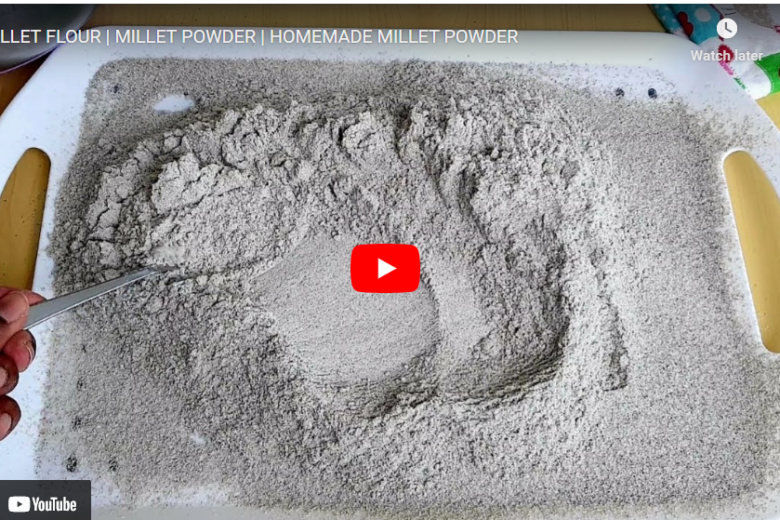Millet is a nutritious grain that has been cultivated for thousands of years and is widely consumed as a staple food in many parts of the world. Millet flour is a gluten-free alternative to wheat flour that is gaining popularity among people with gluten sensitivities or celiac disease.
Processing millet into flour can seem daunting for those who have never done it before, but with the right equipment and knowledge, it can be a straightforward and rewarding process.
Processing millet into flour is a relatively simple process that requires minimal equipment. First, the millet must be dry-roasted to enhance the flavor of the flour. After it has cooled, the grains can be ground in a food processor, mill, or blender until it has reached a fine, powdery consistency. This flour can then be used for various baking recipes or as a substitute for other grains in a variety of dishes.
How to Process Millet into Flour Step By Step Guide
Processing millet into flour is divided into four stage. The stages include preparation, processing, and storage. These stages have in themselves individual steps to follow.
Preparation Stage
The preparation stage is the first phase of processing millet into flour. Follow the step below to achieve this stage
Read Also: How To Process Cashew Nuts At Home
Step 1. Gather the Equipment
Before you begin processing millet into flour, it is essential to gather the necessary equipment and ingredients. You will need a grinding machine or mortar and pestle, a fine mesh sieve, and a clean and dry container for storing the flour.
Step 2. Source for Quality Millet
It is also important to source good quality millet. Choose millet that is free from impurities such as stones, dirt, or other foreign matter, and has a uniform color and texture.
Read Also: How To Process Cassava to Garri
Step 3. Clean the Millets
Once you have your millet, you need to clean it thoroughly to remove any debris. Rinse the millet in a fine mesh strainer under running water and discard any particles that float to the surface.
Alternatively, you can use a food-grade bucket filled with water to wash the millet. Swirl the millet in the water and discard any debris that floats to the top.
Read Also: How To Process Coconut Oil
Step 4. Dry the Millet
After washing the millet, you should dry it completely before processing it. Spread the millet out on a clean towel or a baking sheet and allow it to air dry for several hours.
Ensure that the millet is completely dry before grinding it; otherwise, it may not grind properly, and the resulting flour may spoil quickly.
In addition to the equipment and preparation steps above, it is important to follow good hygiene practices when processing millet into flour.
Read Also: How To Process Maize Into Flour
Wash your hands thoroughly before handling the millet, and ensure that all the equipment used is clean and dry to prevent contamination.
This will ensure that the millet flour you produce is of high quality and safe for consumption.
Processing Stage
Now that you have your clean and dry millet, it’s time to process it into flour. There are several methods you can use to grind millet into flour, including using a grinding machine or a mortar and pestle.
Processing using Grinder
If you have a grinding machine, place the millet grains in the machine’s hopper and turn it on. The millet will be ground into flour and collected in the machine’s container.
You may need to run the millet through the grinder several times to achieve the desired fineness of the flour.
It is essential to monitor the grinding process carefully to avoid overheating the millet, which can affect the quality of the flour.
Processing Using Mortar and Pestle
This is the manual method of processing millet into flour. If you are using a mortar and pestle, grind the millet in small batches to ensure an even consistency.
Place a handful of millet in the mortar and use the pestle to grind it into a fine powder. Repeat until you have ground all the millet into flour.
Sifting
Once you have ground the millet into flour, sift it through a fine mesh sieve to remove any large particles or pieces of millet that may remain. This will ensure that your flour is smooth and even.
Storage Stage
After processing your millet into flour, it’s essential to store it properly to ensure it stays fresh and doesn’t spoil quickly. The key to storing millet flour is to keep it in a cool, dry place away from direct sunlight and moisture.
Store your millet flour in an airtight container to prevent moisture and air from getting in, which can cause the flour to spoil quickly. You can use a plastic or glass container with a tight-fitting lid or a resalable plastic bag.
Label your container with the date of processing to help you keep track of its freshness. Millet flour can last for several months if stored properly, but it’s best to use it within three months for optimal freshness and quality.
If you notice any signs of spoilage, such as a sour smell, mold, or discoloration, discard the flour immediately as it can make you sick if consumed.
It’s essential to check your millet flour periodically for signs of spoilage, especially if you haven’t used it in a while. You can do this by smelling it and checking for any discoloration or signs of mold.
Proper storage of millet flour is crucial to ensure it stays fresh and safe for consumption. By following the tips above, you can enjoy your homemade millet flour for months to come.
Uses of Millet Flour
Millet flour is a versatile and nutritious ingredient that you can use in a variety of dishes. It has a mild, slightly sweet flavor that pairs well with many ingredients, making it a popular choice for gluten-free and vegan recipes.
- You can use millet flour as a substitute for wheat flour in many recipes, such as bread, pancakes, and muffins. It is also an excellent alternative to cornmeal in recipes like polenta and cornbread.
- Millet flour is an excellent thickener for soups and stews and can add a nutty flavor to sauces and gravies. You can also use it to make gluten-free pasta and noodles.
- Millet flour is a popular ingredient in Indian cuisine, where it’s used to make traditional flatbreads like roti and dosa. It’s also used in African cuisine to make porridge, bread, and beer.
- Millet flour is also a nutritious ingredient that can provide many health benefits. It’s high in protein, fiber, and antioxidants, making it an excellent choice for maintaining good health.
Advantages of Processing Millet into Flour
Processing millet into flour has several advantages, including:
1. Versatility
Millet flour is a versatile ingredient that you can use in a wide range of dishes, from bread and pasta to soups and stews.
2. Gluten-free
Millet flour is naturally gluten-free, making it an excellent alternative to wheat flour for people with gluten intolerance or celiac disease.
3. Nutritious
Millet flour is high in protein, fiber, and antioxidants, making it a nutritious ingredient that can help maintain good health.
4. Affordable
Millet is a relatively inexpensive grain, making millet flour a budget-friendly alternative to other gluten-free flours.
5. Sustainable
Millet is a drought-resistant crop that requires minimal water and can grow in harsh conditions, making it a sustainable option for farmers and consumers.
Disadvantages of Processing Millet into Flour
While processing millet into flour has several advantages, there are also some potential disadvantages to consider:
Short Shelf Life
Millet flour has a shorter shelf life than wheat flour due to its higher fat content. It can spoil quickly if not stored properly, which may lead to food waste.
Limited Availability
Millet flour may not be as readily available as wheat flour in some areas, which can make it difficult to source.
Different Texture and Flavor
Millet flour has a different texture and flavor than wheat flour, which may not be suitable for all recipes or personal preferences.
Processing Challenges
Millet flour can be more difficult to process than wheat flour due to its small size and hardness. This can require specialized equipment or techniques, which may be more costly or time-consuming.
Benefit of Processing Millet into Flour
Processing millet into flour provides several benefits, including:
Increased nutrition
Millet flour is a nutritious ingredient that is high in protein, fiber, and antioxidants. By processing millet into flour, you can access these nutritional benefits and incorporate them into your diet.
Versatility
Millet flour is a versatile ingredient that can be used in a variety of dishes, from bread and pasta to soups and stews. This versatility makes it a great ingredient for experimenting with new recipes and adding variety to your diet.
Sustainable
Millet is a drought-resistant crop that requires minimal water and can grow in harsh conditions. By using millet flour, you can support sustainable agriculture practices and reduce your environmental footprint.
Where to Sell Millet Flour
If you are interested in selling millet flour, there are several options available to you:
Online Marketplaces
There are many online marketplaces such as Amazon, Etsy, and eBay that allow you to sell your products to a large audience. These platforms provide a convenient way to reach customers worldwide, and you can easily set up an online store to sell your millet flour.
Local Health Food Stores
Many health food stores specialize in selling natural and organic products, including alternative flours such as millet flour. Contact your local health food store to see if they are interested in stocking your millet flour.
Farmers Markets
Selling at a farmers market is a great way to connect with your local community and reach customers who are interested in buying local and sustainable products. You can set up a booth at a farmers market and sell your millet flour directly to customers.
Distributors And Wholesalers
If you are interested in selling your millet flour in bulk, you can consider working with distributors and wholesalers. These companies can help you reach a larger market and can provide assistance with packaging, labeling, and shipping your products.
Online Food Subscription Services
There are several online food subscription services that allow customers to receive monthly shipments of organic and natural products, including alternative flours like millet flour. Research subscription services that align with your values and reach out to see if they would be interested in featuring your millet flour in their boxes.
Industries that Demand for Millet Flour
There are several industries that demand millet flour as an ingredient in their products. Here are a few examples:
Baking Industry
The baking industry uses millet flour as a gluten-free alternative to wheat flour in bread, cakes, cookies, and other baked goods. Millet flour’s unique nutty flavor and fine texture make it a popular choice for gluten-free baking.
Food Service Industry
The food service industry, including restaurants and cafes, use millet flour to create a range of dishes, from gluten-free pancakes and waffles to savory items like millet-based veggie burgers.
Snack Industry
The snack industry has seen an increase in demand for healthier snack options, and millet flour is a popular ingredient in many gluten-free and plant-based snack products like crackers, chips, and popcorn.
Baby Food Industry
Millet flour is a common ingredient in baby food products as it is easy to digest and provides essential nutrients like protein and fiber. Millet-based baby cereals and porridges are popular options for parents looking for nutritious and natural food options for their infants.
Pet Food Industry
Millet flour is also used in the pet food industry as an ingredient in natural and organic pet food products. Millet flour provides a good source of carbohydrates and protein for pets, and its gluten-free properties make it an excellent choice for pets with allergies or sensitivities.
Overall, the demand for millet flour is growing as more people seek out healthier and gluten-free food options. With its versatility and nutritional benefits, millet flour is an excellent ingredient for a wide range of industries, from baking to pet food.
How To Make Millet Flour For Swallow
To prepare millet flour for swallow, you first need to have millet flour available. If you haven’t processed the millet into flour yet, you can follow the steps outlined below.
Once you have the millet flour, you can prepare the millet swallow as follows:
Step 1. Boil Water
In a pot, bring water to a boil.
Step 2. Add Millet Flour
Gradually add the millet flour to the boiling water, while stirring continuously with a wooden spoon or spatula. Keep stirring until the mixture forms a smooth and thick consistency.
Step 3. Reduce Heat And Continue Stirring
Once the mixture starts to thicken, reduce the heat and continue stirring to prevent lumps from forming. If necessary, you can add more water or millet flour to achieve the desired consistency.
Step 4. Cover And Cook
Cover the pot and let the millet swallow cook for about 5-10 minutes on low heat. This will help the swallow cook properly and remove any raw taste.
Step 5. Serve Hot
After cooking, turn off the heat and let the millet swallow cool for a few minutes before serving it hot with soup or stew of your choice.
Millet swallow is a delicious and nutritious alternative to other types of swallows and can be enjoyed by everyone, especially those with gluten intolerance or celiac disease.
How To Make Millet Powder For Baby
To make millet powder for baby, follow these steps:
Choose good quality millet
Select millet that is free from impurities such as stones, dirt, or other foreign matter, and has a uniform color and texture.
Clean the millet
Rinse the millet in a fine mesh strainer under running water and discard any particles that float to the surface. You can also use a food-grade bucket filled with water to wash the millet. Swirl the millet in the water and discard any debris that floats to the top.
Dry the millet
Spread the millet out on a clean towel or a baking sheet and allow it to air dry for several hours. Ensure that the millet is completely dry before grinding it; otherwise, it may not grind properly, and the resulting flour may spoil quickly.
Grind the millet
Use a grinding machine or mortar and pestle to grind the millet into a fine powder. For a smoother texture, you can pass the ground millet through a fine mesh sieve.
Store the millet flour
Transfer the millet flour into a clean and dry container and store it in a cool, dry place. Millet flour can be stored for up to 6 months if properly stored.
How To Make Millet Flour Chapatti
To make millet flour chapatti, you will need the following ingredients:
- 1 cup of millet flour
- 1/2 cup of water
- 1/2 teaspoon of salt
- 1 tablespoon of oil (optional)
Here are the steps to follow:
Step 1. Mix the ingredients
In a mixing bowl, combine the millet flour, salt, and oil (if using). Gradually add water to the mixture while kneading it with your hands. Continue to knead until you form a soft and smooth dough. The dough should be neither too dry nor too sticky.
Step 2. Rest the dough
Once you’ve achieved the desired consistency, cover the dough and let it rest for about 20-30 minutes. This will make it easier to roll out the chapattis.
Step 3. Divide the dough
After resting the dough, divide it into small portions, roughly the size of a golf ball. Roll each portion between your palms to form a smooth ball.
Step 4. Roll out the chapattis
Using a rolling pin, roll out each ball into a thin, round shape. Dust the rolling surface with millet flour to prevent sticking.
Step 5. Cook the chapattis
Heat a frying pan or griddle on medium-high heat. Once the pan is hot, place the rolled-out chapatti on it and cook for about 30 seconds on each side, or until it starts to bubble and brown slightly. Flip and repeat on the other side until it is fully cooked.
Step 6. Serve hot
Once cooked, remove the chapatti from the pan and serve hot with your favorite dish.
Millet flour chapatti is a healthy and nutritious alternative to traditional wheat chapattis, and can be enjoyed by anyone, especially those with gluten intolerance or celiac disease.
Millet Flour Recipes
Millet flour is a versatile and nutritious ingredient that can be used to make a wide variety of recipes. Here are a few examples of millet flour recipes:
Millet Flour Bread
Millet flour can be used to make delicious and healthy bread. Mix millet flour with all-purpose flour, yeast, salt, and warm water to form a dough. Knead the dough and let it rise before baking in the oven.
Millet Flour Pancakes
Millet flour can also be used to make fluffy and delicious pancakes. Mix millet flour with baking powder, salt, milk, eggs, and melted butter. Cook the pancakes on a griddle or frying pan and serve with your favorite toppings.
Millet Flour Porridge
Millet flour can be used to make a hearty and nutritious porridge. Mix millet flour with water or milk, and cook on low heat until thick and creamy. Add sweeteners and toppings to taste.
Millet Flour Cookies
Millet flour can be used to make tasty and healthy cookies. Mix millet flour with sugar, butter, egg, baking powder, and vanilla extract. Roll out the dough, cut into shapes, and bake in the oven.
Millet Flour Chapatti
Millet flour can also be used to make nutritious and tasty chapattis. Mix millet flour with water and salt to form a dough. Roll out the dough, cook on a griddle or frying pan, and serve hot with your favorite dish.
These are just a few examples of the many recipes that can be made with millet flour. Millet flour is a versatile and healthy ingredient that can be used to make a variety of delicious and nutritious dishes.
Millet Flour Porridge
Millet flour porridge is a nutritious and satisfying breakfast or snack that is easy to make. Here is a simple recipe for millet flour porridge:
Ingredients:
- 1 cup millet flour
- 3 cups water or milk
- 1/4 teaspoon salt
- Sweeteners and toppings to taste (e.g. honey, fruits, nuts, etc.)
Instructions:
- In a medium-sized saucepan, whisk together the millet flour, water or milk, and salt until well combined.
- Heat the mixture over medium heat, stirring constantly, until it comes to a boil.
- Reduce the heat to low and let the mixture simmer for about 10 minutes, stirring occasionally until it thickens to a porridge-like consistency.
- Remove the saucepan from the heat and let the porridge cool for a few minutes before adding any sweeteners or toppings.
- Serve the millet flour porridge warm with your favorite toppings, such as honey, fruits, nuts, or seeds.
Conclusion
Processing millet into flour can be a fun and rewarding experience. Homemade millet flour is a healthier and cost-effective alternative to store-bought flour. It is also gluten-free, making it an excellent choice for people with gluten sensitivities or celiac disease. So why not give it a try and see how you can incorporate this versatile flour into your cooking and baking?




